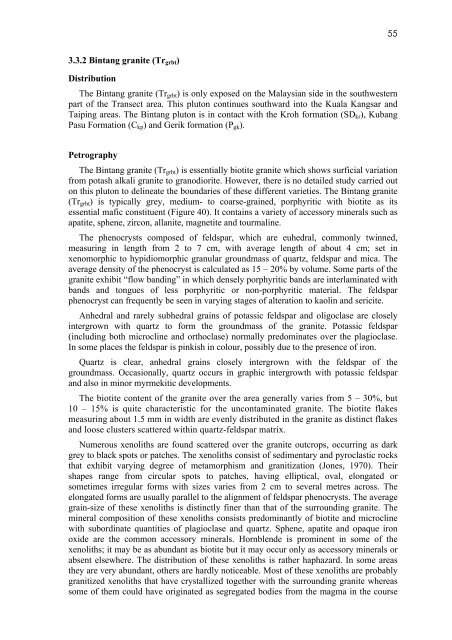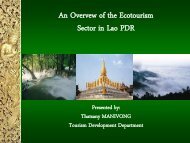GEOLOGY OF THE PENGKALAN HULU-BETONG TRANSECT ...
GEOLOGY OF THE PENGKALAN HULU-BETONG TRANSECT ...
GEOLOGY OF THE PENGKALAN HULU-BETONG TRANSECT ...
Create successful ePaper yourself
Turn your PDF publications into a flip-book with our unique Google optimized e-Paper software.
3.3.2 Bintang granite (Trgrbt)<br />
Distribution<br />
The Bintang granite (Trgrbt) is only exposed on the Malaysian side in the southwestern<br />
part of the Transect area. This pluton continues southward into the Kuala Kangsar and<br />
Taiping areas. The Bintang pluton is in contact with the Kroh formation (SDkr), Kubang<br />
Pasu Formation (Ckp) and Gerik formation (Pgk).<br />
Petrography<br />
The Bintang granite (Trgrbt) is essentially biotite granite which shows surficial variation<br />
from potash alkali granite to granodiorite. However, there is no detailed study carried out<br />
on this pluton to delineate the boundaries of these different varieties. The Bintang granite<br />
(Trgrbt) is typically grey, medium- to coarse-grained, porphyritic with biotite as its<br />
essential mafic constituent (Figure 40). It contains a variety of accessory minerals such as<br />
apatite, sphene, zircon, allanite, magnetite and tourmaline.<br />
The phenocrysts composed of feldspar, which are euhedral, commonly twinned,<br />
measuring in length from 2 to 7 cm, with average length of about 4 cm; set in<br />
xenomorphic to hypidiomorphic granular groundmass of quartz, feldspar and mica. The<br />
average density of the phenocryst is calculated as 15 – 20% by volume. Some parts of the<br />
granite exhibit “flow banding” in which densely porphyritic bands are interlaminated with<br />
bands and tongues of less porphyritic or non-porphyritic material. The feldspar<br />
phenocryst can frequently be seen in varying stages of alteration to kaolin and sericite.<br />
Anhedral and rarely subhedral grains of potassic feldspar and oligoclase are closely<br />
intergrown with quartz to form the groundmass of the granite. Potassic feldspar<br />
(including both microcline and orthoclase) normally predominates over the plagioclase.<br />
In some places the feldspar is pinkish in colour, possibly due to the presence of iron.<br />
Quartz is clear, anhedral grains closely intergrown with the feldspar of the<br />
groundmass. Occasionally, quartz occurs in graphic intergrowth with potassic feldspar<br />
and also in minor myrmekitic developments.<br />
The biotite content of the granite over the area generally varies from 5 – 30%, but<br />
10 – 15% is quite characteristic for the uncontaminated granite. The biotite flakes<br />
measuring about 1.5 mm in width are evenly distributed in the granite as distinct flakes<br />
and loose clusters scattered within quartz-feldspar matrix.<br />
Numerous xenoliths are found scattered over the granite outcrops, occurring as dark<br />
grey to black spots or patches. The xenoliths consist of sedimentary and pyroclastic rocks<br />
that exhibit varying degree of metamorphism and granitization (Jones, 1970). Their<br />
shapes range from circular spots to patches, having elliptical, oval, elongated or<br />
sometimes irregular forms with sizes varies from 2 cm to several metres across. The<br />
elongated forms are usually parallel to the alignment of feldspar phenocrysts. The average<br />
grain-size of these xenoliths is distinctly finer than that of the surrounding granite. The<br />
mineral composition of these xenoliths consists predominantly of biotite and microcline<br />
with subordinate quantities of plagioclase and quartz. Sphene, apatite and opaque iron<br />
oxide are the common accessory minerals. Hornblende is prominent in some of the<br />
xenoliths; it may be as abundant as biotite but it may occur only as accessory minerals or<br />
absent elsewhere. The distribution of these xenoliths is rather haphazard. In some areas<br />
they are very abundant, others are hardly noticeable. Most of these xenoliths are probably<br />
granitized xenoliths that have crystallized together with the surrounding granite whereas<br />
some of them could have originated as segregated bodies from the magma in the course<br />
55



